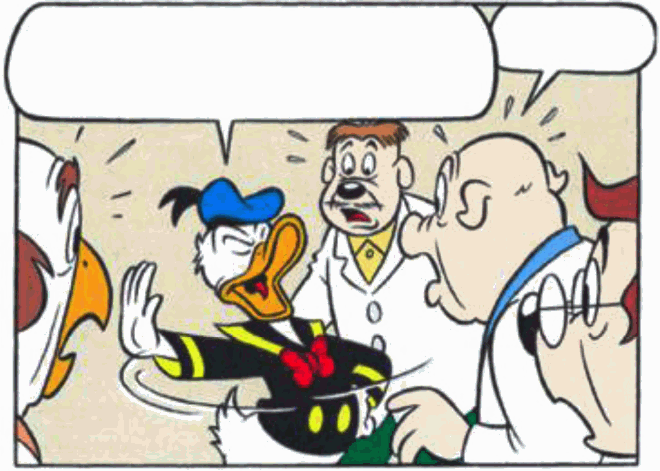ABSTRACT
This article combines theory on comics, narrative, and discursive psychology and analyses how the gutter is co-constructed for storytelling in classroom interaction. Closure of the gutter has previously been treated as a cognitive aspect. Here, interactional video data are analysed, with participants organizing ten separate comic panels. The analysis focuses on participants’ talk about the gutter, and how this constructs social actions. The results show how participants co-construct the gutter as meaningful space, hereby organizing time, actions, and events in narratives. The paper evinces that gutters are co-constructed as too narrow or too broad, relating chronologically and logically to surrounding panels. This contributes to sociocultural perspectives on literacy and use of comics for engaging with narratives in classroom practice.
Introduction
Most people are familiar with comic books, or comics,Footnote1 in one form or another, having read them as children, adolescents, or adults. Although comics have been around for over a century, and there has been research on them as educational materials for almost as long (for a few examples see Cary, Citation2004; Hammond, Citation2009; Pantaleo, Citation2013, Citation2015; Tilley & Weiner, Citation2017), it is difficult to find research on the use of comics for doing literacy as in situ school practice (cf. Tilley & Weiner, Citation2017). In Sweden, comic publishing, especially for children, has increased in the last few years (Swedish Institute for Children’s Books, Citation2016). This fact, combined with an increased interest in comics as school materials on the side of publishers (see, e.g., Egmont Publishing, Citation2015), has led to more public attention (af Sandeberg, Citation2013; Bengts, Citation2013; Ohlin, Citation2014) given to comics. All in all, this raises questions about how teachers and pupils work with comics in the classroom.
Working with comics, a juxtaposed pictorial narrative in sequence (cf. McCloud, Citation1993), means working with a unique storytelling format (Bongco, Citation2000). There are many aspects of comics that deserve attention, and only so much space in a single article. As such, the current paper focuses on one of the distinguishing visual narrative characteristics of comics: the gutter – the blank area between individual comic panels – the non-space, most often left empty by the comic book author (Dittmer, Citation2010; Eisner, Citation2008; McCloud, Citation1993; Postema, Citation2013). As this article will show, however, the reader seldom leaves these spaces empty; but how do readers go about filling these spaces in practice? The current article investigates an instructional activity in which a group of primary school pupils place individual cut-out comic panels next to each other, co-constructing narratives in the created gutter space, guided by their teacher. Through a theoretical lens of discursive psychology, narrative theory, and comics theory, this study demonstrates how participants construct narrative structures as social actions, rather than mental structures, to perform discourses of comics literacy, thereby producing the gutter as a place of meaning.
The Gutter in Theory
In their very basic form comics consist of two structural parts, the panels and the gutter. In his literary study of comics, Douglas Wolk (2007) argues that one of the panel’s most important functions is to enable pregnant moments (borrowing the term from the 1776 essay Laocoön by Gotthold Efraim Lessing), spaces where readers contribute by giving birth “not to the next but to the space before the next” (p. 131, emphasis added); this space is the gutter. Similarly, David Low (Citation2012) emphasizes “a continual, active communication between author and reader,” a process he calls gutterance (p. 372), taking place. Gutterance occurs when individual panels allow readers to project coming, unknown spaces. Regardless of the size of the gutter – from broad, blank space to thin black line – “there is always a gap between fragmented moments”, Barbara Postema (Citation2013, p. 49) writes, and these gaps “continuously ask to be filled” (p. 125).
The gutter provides opportunities for readers to add their own narrative details, creating a story that transcends the panels and text. In Understanding Comics, Scott McCloud (Citation1993) demonstrates how this process is deliberately used by the comic book artist to leave information out in the panel-to-panel transition, and McCloud further theorizes that this leaves it to the reader to construct the gutter content and make the transition meaningful. Similarly, Will Eisner (Citation2008) argues that with comics, the reader has to “arrange the sequence of events (or pictures) so as to bridge the gaps in action” (p. 39), although neither author has studied this reading empirically. Low (Citation2012) does give examples from his own teaching experiences of putting the gutter in focus, arguing that it is important to “isolate for attention the rich meaning-making spaces of the gutter” (p. 382), and suggests that gutters in comics challenge readers with “the task of co-authoring the entire narrative using their own inferences” (p. 376). However, besides the anecdotal examples, he lacks empirical studies of this practice – a gap that the current article means to fill. Similarly, Rocco Versaci (Citation2008) demonstrates how to use a collection of separate panels in discussing constructions of narrative. This is very similar to the exercise done by the participants in the current article, but Versaci focuses on the literary material, the comics themselves, and their possibilities for classroom work (what could be done?), rather than the actual literacy practice done with them. As such, it is interesting to further investigate this social practice in situ.
Whether one calls this visual reading process closing of the gap (Iser, Citation1978), closure (McCloud, Citation1993), or transition (Eisner, Citation2008), construction of the gutter is not new, and remains a process whereby “human imagination takes two separate images and transforms them into a single idea” (McCloud, Citation1993, p. 66). As a visual element the gutter may be characteristic of comics, but picture books, film, novels, and other types of media use similar kinds of telling gaps, tell-tale gaps, gapping, or page breaks (see, e.g., Herman, Jahn, & Ryan, Citation2005; Sipe & Brightman, Citation2009); all structural narrative elements with functions similar to that of the gutter.
As an empirical example of research on readers constructing narrative visual elements, albeit not specifically with comics, Lawrence Sipe and Anne Brightman (Citation2009) have investigated young children’s interpretation of page breaks in picture books. Emphasizing the semiotic significance of the turning of the page in picture books, they investigate how second graders make meaning out of page breaks when forming narratives. Among other things, their results show that speculation around characters’ actions, imaginary dialogue, thoughts and feelings, change of setting, and speculation on amount of time are all different ways in which children interpret the gaps. Going “well beyond literal recall of story elements”, the authors suggest that this approach enables an “enriched understanding of literature” whereby children “make inferences, connecting elements by cause-and-effect relationships, so that the story is more than a collection of incidents or isolated details” (p. 77).
Thus, the gutter is a space for reader sense-making, common to many types of fiction; thus studying how a narrative is done through the construction of the gutter is relevant not only for comics, but also a broader field of literacy.
Structuring the Comics Narrative
When structuring separate comic book panels into a sequence (e.g., a comic strip), the reader constructs narratives, single frames forming coherent stories recounting one or more events in a temporal sequence (Herman et al., Citation2005; McCloud, Citation1993; Prince, Citation1987). Studies of narratives, regardless of the literary format, focus on the form and function of the narratives – elements of structure, story, and plot – and how these come together to form an organized storytelling (Culler, Citation1997; Prince, Citation1982). Concerning images used for narration, Werner Wolf (Citation2003) concludes that the narrative in visual arts is best represented “in serial or multiphase pictures” (p. 192). Thus, building on Gerald Prince’s (Citation1982, Citation1987) theory of narratology, and a view of narratives including pictorial representations (Wolf, Citation2003), the current article analyses participants’ verbal and non-verbal interactions when co-constructing (simultaneously creating and reading) narratives with comic book panels.
So how can one study narratives in school practice? As one example, based on narrative as a cognitive mode of making sense of the world (Bruner, Citation1986; Wells, Citation1986), Diane Zigo (Citation2001) explores the use of narrative theory with middle school pupils working with reading comprehension strategies. Her results reveal that “nearly every child in both classrooms became more engaged with text and more able to develop and sustain interpretations of fiction and nonfiction when allowed to explore the text through narrative” (p. 64). In Zigo’s study, both teacher and pupils engaged in narratives, either provided texts or their own constructed narratives. These varied in length from role-playing in colonial USA stretching over several lessons, to one-sentence hypotheses in the form of “suppose that you and I sat down at this table … ” (p. 66). Zigo demonstrates pupil recall of vocabulary and use of critical thinking through the use of narratives. She also encourages teachers to consider the value of narrative thinking to increase pupils’ “retaining and making use of information” (p. 68).
As panel transitions are key to the sequential narrative structure of comics (Eisner, Citation2008; Groensteen, Citation2007; McCloud, Citation1993; Postema, Citation2013), this also makes the interactional construction of the gutter important when studying how narrative structure is done in education. As indicated above, the closing of literary gaps has often been viewed as a cognitive process whereby the individual’s mind closes the gap between comic panels (Cohn, Jackendoff, Holcomb, & Kuperberg, Citation2014; Iser, Citation1978; Low, Citation2012; McCloud, Citation1993). Adding new perspectives to this body of knowledge, the current article instead approaches the co-construction of comic’s narratives as a sociocultural interactional literacy practice (cf. Gee, Citation1992, Citation2002).
Studying the Narrative Gutter as a Social Practice
In the current article, groups of nine-year-old primary school pupils and their teachers work with separate comic book panels in the task of arranging them in sequential order and creating a story from them. This study constitutes a microanalysis of four pupils and one teacher, offering essential insight into the in situ interactional process of co-constructing comics narratives, and how pupils and teacher negotiate gutter construction throughout this process.
With a focus on three primary aspects – action orientation, situation, and construction – discursive psychology (DP) studies psychology as something participants perform in interaction, and text and talk as inherently performing social practices (Edwards & Potter, Citation1992; Potter, Citation1996; Wiggins, Citation2017). The current article treats discourses of literacy as being constructed and reconstructed by individuals and groups in social contexts with the resources and information at the participants’ disposal (cf. Gee, Citation1992, Citation2002).Footnote2 As such, it is not relevant how a reader constructs an idea of the gutter, or the narrative structure, in their own mind (see, e.g., Cohn et al., Citation2014; Cohn, Paczynski, Jackendoff, Holcomb, & Kuperberg, Citation2012), but rather how participants talk about these structures – in this case, their reading of a sequential narrative (Bongco, Citation2000) – in social interaction in the context of a classroom group, and what social action this performs. For the purposes of the analysis in the current article, pupils and teachers are both constructing narratives (“writing”) and “reading” them in situ – as they are putting together their own comic stories piece by piece, structuring and restructuring them as they go along. As such, participants are considered simultaneous readers and producers of the comic’s narrative.
To give an example, it has been argued that, when looking at two images, the reader makes mental connections between these images (e.g., McCloud, Citation1993), but the current article studies how these connections would be negotiated, constructed, and reconstructed in social context, rather than as a mental process. The narrative of sequential images is not there to begin with, but is rather something we create. This study focuses on the social construction of narrative that happens between individuals.
As part of DP practices, video recordings, along with transcriptions of talk and movement, have been studied with a focus on the interactional resources, sequential practices, and discourses utilized by participants to perform social actions. Earlier research with discourse and school reading practices include, for example, studies of dilemmas in booktalk constructions of reader identities (Eriksson, Citation2002; Eriksson Barajas & Aronsson, Citation2009). The current study adds to this by exploring how participants construct aspects of comics narrative – what would often be described as individual cognitive structuring of narrative – as social action (Potter, Citation1996; Wiggins, Citation2017). This way, talk about the gutter has been found, consisting of sequences in which participants verbally and/or physically form narrative structures while drawing on narrational gaps. Thus, three perspectives of study come together: school literacy practices, discursive psychology, and comic studies.
Data and Participants
The data in this article are taken from a larger dataset, created with three classes in a primary school and one class in a secondary school. The data were recorded as part of a study of comics in education, which involved 6 teachers and 77 pupils in Grade 3 (9 years old) and Grade 8 (14 years old) in compulsory school, totalling 36 hours, or 15 lessons. The data analysed in the current article have been taken from one class in Grade 3 and their teacher, residing in a larger city in Sweden. All names have been changed, and images have been edited, for reasons of anonymity.
This school was working on a project in collaboration with a publishing company, Egmont Publishing, trying out the use of comics for language and literacy learning over a period of three weeks, and the researcher was granted permission by all parties involved – publisher and teachers, as well as pupils and their guardians – to study this process. The teachers claimed to have no previous experience working with comics, and comics are not specifically covered by the curriculum for Swedish (although curriculum subject content related to literacy and language could of course be applied to comics as well; see Swedish National Agency for Education, Citation2011). The 10 comic panels used by the participants in the data are taken from a Donald Duck comic consisting of a total of 60 panels (Troelstrup & Santanach, Citation2013) and are part of teacher material available online (Galaczy, Citation2013, see also Appendix 1),Footnote3 and the teachers themselves chose what to use from this material in exchange for feedback to the publisher. As only 10 out of 60 panels are used, there is little connection between the panels, as will be shown and discussed below. However, this is the material as it was designed by Egmont, and what the teachers chose to use. It should be noted that the author of the current article is not part of the Egmont project but has merely studied it, is under no obligation to report to Egmont, and has no connections to the publisher, financial or otherwise.
Recording and Transcription
Four video cameras and three audio recorders were used in each studied classroom in order to capture talk, gestures, gaze, and use of the comic book material. Word-for-word transcriptions of verbal talk with notes on embodied interaction were first made by the researcher, as an aid in the first phase of finding interactional sequences and topics of interest (cf. Linell, Citation1994). At this point, the recordings were reviewed (or “read,” cf. Wiggins, Citation2017) for possible sequences of interaction in which participants engaged with comics as part of social action – this could include assessments, extreme case formulations, or other discursive devices (Wiggins, Citation2017) – as relevant to the overarching research interest of doing literacy with comics. Note that at this stage a specific device did not need to be identified. Merely finding a potential one could be grounds for saving it for further analysis. As sequences were selected for further review and analysis (see below for details on the methodology), detailed written transcriptions were made based on the Jeffersonian style (Jefferson, Citation2004, see also Appendix 2). This transcription covers talk, but also embodied actions. However, in order to not clutter transcriptions needlessly, aspects such as body language, gesture, or gaze were only included in the transcription if considered relevant for the analysed social action. As the analysis is made from the original Swedish talk, this is the basis of the transcription. In the process of writing the article, the transcripts have been translated into English by the author, and proofread by a professional translator whose native language is English.
Comic panelsFootnote4 are attached in Appendix 1, and have been numbered in the article excerpts for the sake of reference. The panels were not numbered in the classroom, and have no specific order for the participants. Comic panels made relevant as part of the interaction are shown in the transcripts, and when participants’ embodied action is of specific interest, frame grabs from the video data are also shown.
Using Discursive Psychology to Analyse Literacy Practices
Investigating interactional aspects such as intonation, repetition of phrases and words, upgrades, and participants’ physical and verbal manipulations of panels and panel structure, the excerpts have been analysed systematically and repeatedly, using a participant-oriented perspective, asking how a certain action is performed (Wiggins, Citation2017). A collection of 17 excerpts has been compiled, wherein talk about the gutter is made interactionally relevant. Since this seems to be an unexplored phenomenon, it was relevant to allow enough space to properly unpack the events shown; therefore, two excerpts were analysed in detail and are presented in this article as representative of the two different aspects of gutter talk analysed here. These two excerpts are taken from the same lesson, described further below.
Drawing on the above, the current article uses a discursive psychological methodology, while building on narrative theory and comics theory around the gutter.
Aim
The aim of the article is to contribute to the study of literacy, comic studies, and discursive psychology, by demonstrating how classroom participants socially construct and negotiate the gutter of comics as a narrative space, something usually thought of as a mental construction. This impacts classroom work on literacy, and shows how working with comics can influence teaching narrative, causal relations, and the use of images for storytelling. The following questions guide the analysis:
How do participants construct the gutter as part of the comics narrative?
How do participants negotiate their gutter construction as part of the group’s comics narrative?
Co-constructing a Comics Narrative in the Gutter
The following analysis demonstrates how the teacher orients to a physically non-existent narrative structure, using manipulation of the physical panels, as well as verbal talk, to construct narrative content between two comic book panels. The first excerpt shows how participants negotiate narrative actions and events as constructed in the gutter, rather than in the panels themselves, which demonstrates the strength of the gutter as a narrative space in making these events and actions possible. The second excerpt then shows that the gutter is not limitless, and that surrounding panels guide the participants in negotiating this narrative space into something that logically fills out the space between. These negotiations are done both verbally and physically, through the placement and re-placement of panels, pointing, and so on, and often focus on a co-construction, with the teacher emphasizing agreement within the group, using verbal markers to indicate cohesion, rather than dissonance, between members.
In the two excerpts presented here, a group consisting of four pupils and their teacher, Anna, are working with an assignment in which they are making a story sequence out of 10 separate comic strip panels. The pupils’ task is to create a story using all 10 panels (see Appendix 2), in any order. The main goal of this task, as presented by the teacher, is to cooperate, discuss, and construct a story, paste the panels onto two posters, and write the story below the panels. As such, there is no correct solution to the puzzle of comic images, as far as the participants are concerned, even though the images are designed in a certain order in the comic book from which they are taken.
Actions and Events in the Gutter
In Excerpt 1, participants argue for a construction of the gutter focusing on what events and actions could take place in this space, and their arguments further relate to what limits the gutter can have. As the excerpt starts, the group is deciding what the second panel will be in the sequence (they have already decided on panel 9 as the first). The teacher, Anna, has the first turn:
Excerpt 1. Sonya (s), Eddie (e), Lisa (l), Malin (m), pupils; Anna (A), teacher.
Table
In line 1, there is already a potential gutter being constructed, with one panel placed down, and another to be put next to it. The teacher, Anna, asks what panels the pupils want to rule out as a possible second panel in their comic strip. Sonya suggests removing panel 5, and as Lisa and Eddie start to describe this panel (lines 5–6), Anna gives an argument for why panel 5 could not follow panel 9, because “something of course actually happens here in between” (7) while pointing with her hand between the two panels (Figure 4).
Thus, the participants orient to the panels as a sequential narrative progression (Eisner, Citation2008; Herman et al., Citation2005; McCloud, Citation1993), as is customary in the comics format. The 10 panels, fragmented though they may be, are intended to form a unified temporal story, a temporal code (Postema, Citation2013), having what Thierry Groensteen (Citation2007) calls iconic solidarity, whereby separate panels are interdependent due to how they are presented – thus the importance of their relative placements. By physically placing two panels together in a sequence and adding a progression of time between each panel “something of course actually happens here” (7), the participants enable a construction of (the beginning of) a narrative, making the individual panels sequentially relevant to each other (cf. Dittmer, Citation2010). This is similar to the bilingual participants in Cromdal’s (Citation2003) study who create cartoon strips, with Cromdal analysing the role of language in negotiating and accomplishing power over the produced narrative.
Here, Anna could be referring to the original story from which these panels are taken, but regardless of her intention (since we are not privy to it), the way she encourages the pupils to regard the iconic solidarity of the images is interesting. Her focus on the gutter as “something” (7) constructs this as a mental, imagined construction (that there is something missing between the panels), which she negotiates with the pupils: “are you with me?” (10). McCloud (Citation1993) claims that the mind makes sequences out of separate images. Here, Anna does not have access to the minds of her pupils (see, e.g., Osvaldsson, Citation2016), and cannot know how they would structure the narrative. As such, she instead co-constructs this part of the narrative in situ, through the physical placement and re-placement of panels, as well as verbal phrasings to build up the structure and suggest agreement between the participants.
As an experiential function of narrative, “time can only be linked, in memory or in imagination, with a past and a future” (Wolf, Citation2003, p. 184). These participants orient to a time progression not indicated in the individual panels but one constructed from their view of the panel sequence (e.g., something happens in between; placing them together or not; etc. cf. McCloud (Citation1993), who demonstrates how time can be shown within an individual panel). This construction happens in the gutter between panels. Through construction of the gutter, readers assemble the individual comic book panels into a single, temporally sequential, narrative story.
Sonya’s suggestion to remove panel 5 (line 3) creates a hypothetical gutter (even though the panel is not yet physically on the table), an action requiring consideration from the group. As Eddie and Lisa are describing panel 5, Anna takes it from Lisa (who is holding it at the time) and places it next to panel 9 on the table (line 7). This action by the teacher creates a visible physical gutter observable by the group, rather than merely a hypothetical one, demonstrating how the physical manipulation of the material can serve to help the pupils in their reasoning. This demonstrates how the participants co-construct, and continue to reconstruct, this as a hypothetical narrative, using different panels for suggestions – utilizing different members’ individual suggestions and making them public (cf. Peplow, Swann, Trimarco, & Whiteley, Citation2016).
In lines 7–10, Anna, the teacher, claims that something happens in that gutter, something unknown to the participants. Note that there is no clear disagreement here; Sonya, a pupil, suggests that panel 5 should be removed, and Anna makes no apparent objection to this. Her act of physically placing the panels next to each other could be viewed as a way of arguing for a suggested sequence. However, she instead seems to concern herself with how the process of elimination is being done. She bases this on sense-making of the gutter; what hypothetical actions and events could take place there.
The unknown event in the gutter is used as an argument for why panel 5 should not follow panel 9 “therefore we might not be able to put them together” (8–10). As a narrative experience, reading comic books “incorporates a great deal of openness and ambiguity” (Dittmer, Citation2010, p. 225). Anna points to a logical gap in the narrative structure, which occurs in the gutter. With panel 5 following panel 9, she has not been given a story that makes logical sense (we could imagine an event connecting the two panels logically, but none has been suggested here). This shows that the created gutter does not sufficiently explain how one panel leads to the next, which demonstrates that there are certain limitations on the gutter. When the upper limits of what the gutter can contain are passed, when too much needs to be put between two panels for the sequence to make sense, it might be the case that another panel needs to be put there instead.
Anna performs the action of explaining this to the pupils through the use of certain words: “of course” (7, in Swedish: ju), and “actually” (7, in Swedish: faktiskt), designing her action as an observation of something as being common knowledge between her and the pupils (Heinemann, Lindström, & Steensig, Citation2011).Footnote5 Finally, she asks, “are you with me?” (10), either seeking agreement from the pupils, or checking for their understanding (neither her formulation nor the pupils’ response in line 11 suggests which interpretation is more valid; for different varieties of seeking joint knowledge, see, e.g., Edwards & Mercer, Citation1987). Thus, she seeks confirmation on the co-construction of this narrative, highlighting their role (in the next excerpt, she also reconstructs the narratives the pupils present) rather than merely designing it herself.
The panels used in this excerpt are complex, with a high level of detail and a low level of connection between them (representing only a sixth of the original story). Because of this, participants cannot find a correct narrative (a normatively correct solution), insomuch that the panels are clearly related to each other and follow a specific order; there is no solution or common-sense coherence, so participants need to construct the narrative. So it makes sense that the pupils need to cooperate to construct a narrative from these panels and, as a result of this, the teacher needs to do instructive work on how the pupils can tackle the different obstacles they encounter, and how they argue around this.
What Anna ends up doing in Excerpt 1 pinpoints the co-construction of the gutter as a way to expand the possibilities of actions and events in the narrative storytelling sequence. Her pupils might have to consider other possible options for their story than merely what they see; that is, they need to construct some of the narrative action in the gutter. Peplow et al. (Citation2016) demonstrate how readers develop joint readings and interpretations of texts that are read, and how their views develop through these joint constructions. In the current article, co-constructions of the gutter, through embodied and verbal communication, enable participants to be creative with the material and add more of their own ideas to that which is already shown; to engage with and co-create the story from the panels, instead of merely placing one panel after another and describing what is in them. Of course, as the panels in the assignment were specifically selected (when the publisher designed the material) as having large narrative gaps between them, one could argue that this makes the assignment unrealistic in regard to regular comics reading. However, even when the panels are more closely interconnected, Versaci (Citation2008) argues that “it is not simply a matter of reassembling a linear narrative” (99). The expansion of the gutter here is done as an instruction on the practice of creating narratives, whereby pupils need to consider gaps in the text, and, when necessary, change the sequential order of their story elements in order to better accommodate these gaps. This also performs an action of reflecting on this practice; to consider, as a group, the different aspects of the panels, and the gutter the participants construct between them. This way, the teacher, Anna, guides the pupils into formalising and negotiating the elimination procedure, instead of doing it arbitrarily.
The two aspects of time and activity must be addressed here, as they are narratively entangled. Events and actions could not take place without a time dimension through which to take place (cf. Herman et al., Citation2005). A regular sequence of comic book panels has an almost inherent beat across the page, making it possible for time to pass from one panel to another even without anything in them visually changing (Eisner, Citation2008; McCloud, Citation1993; Postema, Citation2013). Here, since the panels are separated, and of different sizes (which can affect the time perspective; see, e.g., Eisner, Citation2008; McCloud, Citation1993), this means that the participants are responsible for the creation of the gutters as dynamic spaces where actions and events need to be constructed, in relation to time, in order to make logical sense. This will be further explored in the next section.
Defining the Gutter Limits
In Excerpt 1, Anna’s construction of the gutter shows a transition of time and space, an opportunity for something to take place, “something … that we don’t know” (7–8). She does this both verbally, “here”, and physically, by placing panels next to each other and pointing between them (Excerpt 1, Figure 4). This might seem self-evident, but shifting panels can also change the reader’s perspective, instead of moving the objects or characters within them (McCloud, Citation1993). However, it is also an action of showing how much time could realistically take place in the transition between the two panels.
In the second excerpt, it will be further demonstrated how the gutter works in relation to this logic of the narrative structure as a whole, in contrast to the view of individual panels; and a pedagogical problem that arises from this will be noted.
At this point in the lesson, the participants have placed four panels in sequence on their poster (identifying which panels is not relevant here). They are now negotiating whether or not a helicopter in panel 9 is the same one as those shown in other panels, as Anna, the teacher, interrupts the discussion:
Excerpt 2. Eddie (e), Sonya (s) Malin (m), pupils; Anna (A), teacher.
Here, Anna demonstrates a need to consider the panels as a whole, and how participants need to construct at least a minimum of gutter between panels in order for them to fit logically within the sequence. In Excerpt 1, participants worked with one panel at a time, through a process of elimination. In Excerpt 2, however, Anna instead orients to this panel-to-panel thinking as a problem, evinced in her use of “but,” “I think like this,” and “you can’t” (line 2), placing her in opposition to the prior utterances (an argument culminating in the first line of the excerpt as Sonya states that there are many helicopters). At the same time, Anna is not disagreeing with the specific sequence the pupils are suggesting; rather, she is interfering with an ongoing argument that is not constructive. The pupils are not reaching an agreement on how to proceed; after half the lesson, they have still only placed four panels out of ten down. From a teacher’s perspective, Anna demonstrates a desire for the pupils to finish the task at hand, preferably during this lesson – which requires agreement on their part.In order to bring the group back on track, Anna again uses the phrasing “here are of course ten panels” (2, emphasis added), asserting a common-sense view (Heinemann et al., Citation2011; cf. Josephson, Citation2011; Stivers, Citation2011), possibly as a way to unite the divided group. As shown, she addresses the total number of panels on the table. The pupils have the panels in front of them, and can count them if need be, so there is no need to inform them of the actual number. Rather, this is an attempt to help them avoid getting “stuck” (4) in thinking from “one panel [---] to the next” (4), but to look through, consider, and reconsider the entirety of the ten panels (cf. Chute, Citation2008).
Throughout the two excerpts, the teacher’s actions offer two different ways for the pupils to construct their comic book sequence: through engaging either individual panels or the collective set of panels. Both these methods result in problems for the group. As demonstrated earlier, the pupils in Excerpt 2 use details (helicopters) in the panels to determine the order in which they should be placed. The amount of detail in the panels guides the discussion around the narrative and what possibilities the participants have in constructing the story. If, for instance, the illustrator had included a clock in these frames, or if the sky outside had been indicative of some progression of time (cf. McCloud, Citation1993), this discussion could have been completely different. Anna, perhaps aware of the low level of connectedness of the panels (it is not clear whether or not she has read the original comic), asserts that the pupils’ search for “exact clues” (4) within individual panels (the way they have worked so far – constructing minimal gutter action) is not helpful, and that instead a certain amount of content or action must take place in the gutter. In Excerpt 1, Anna orients to an upper limit to how much content can be constructed in the gutter in order for the story to be logically sound. In Excerpt 2, this stated upper limit instead becomes a problem. This shows that the gutter can also be considered too small if the pupils do not account for an appropriate (logical) amount of action taking place within it. The pupils seem to have adopted the practice of not using too much gutter almost too well, and instead the problem becomes that they do not construct enough content in the gutter. Hillary Chute (Citation2008) describes this combination of panel and gutter reading as an “often disjunctive back-and-forth of reading and looking for meaning” (p. 452), something that is put into practice by these participants in their constructions. Readers (and, in this case, they can also be considered producers) use panels as a scaffold for constructing gutter content.
Furthermore, Anna construes this as a pedagogical issue of conflicting instructions, evinced in her utterance “I don’t know exactly how I can explain it to you” (4), orienting to this as a problem for her as an instructor. As an account of working with readers’ narrative competence (Culler, Citation1997), this shows that the construction of logical structure through the use of comic panels is no easy task. Gutter limitations are thus constructed by the participants in their reasoning, both concerning individual panels relating to each other (can panel 5 fit together with panel 9?) and when regarding the narrative as a whole. When the pupils cannot use details in the individual panels to motivate how to put them together, they must instead use the space of the gutter to create the transition from panel to panel (Eisner, Citation2008) and co-construct what is needed to complete their narrative.
Concluding Remarks
The participants in this article, four pupils and a teacher in Grade 3, use 10 comic book panels to co-construct their own comics narrative, negotiating the placement and sequence of the panels. With the aim of contributing to literacy studies, comic studies and discursive psychology, demonstrating how classroom participants socially co-construct and negotiate the comics gutter as a narrative space, this article shows how the group expresses formulations of narrative structure, when it comes to not only singular gutters between individual panels, but also larger structures, and the whole of the sequence. Talk about gutter, or gutter talk, is a multimodal action, both physically creating gutters through the placement and re-placement of the sequence of comic panels, and verbally constructing the space between panels.
This article shows how four pupils and their teacher negotiate different narrative structures. Through the co-construction of the gutter, two distinct actions are performed.
A co-construction of the gutter is done to display a progression of time, events, and actions taking place between two panels, as well as throughout the whole of the sequence. This is a significant narrative aspect, as the co-construction and reconstruction is negotiated between members, resulting in a narrative sequence (cf. Peplow et al., Citation2016). The content of individual panels is talked about in a descriptive way (how these descriptions are framed and phrased could, itself, be further explored in future studies), while gutter content by necessity must be constructed with more or less attachment to panel content. This allows individual pupils to make creative contributions to the collective narrative process, demonstrating their interpretations of separate panels, as well as the panel structure as a whole. The teacher plays a significant role in this, guiding the pupils in their talk, and pushing them to consider the content between panels, as well as the panels themselves.
Participants also perform actions of creating logical connections between panels when constructing narrative content in the gutter, using details in the panels for their arguments. Not just any events, or any amount of time, can go into the gutter; rather, participants need to agree on a construction that makes logical sense for the narrative sequence. The gutter can be constructed as too small (e.g., when readers attempt to link narrative details in two panels directly to each other without any intervening actions or events), but also as too large (e.g., when the constructed gutter content does not sufficiently explain the succeeding panel). The orientation to this coherence in the comics narrative storytelling is maintained by both teacher and pupils, and participants actively negotiate modifications and alternatives to suggested stories, due to disruptions to the narrative: in either time, actions and events, or coherent storytelling.
David Low (Citation2012) suggested that pupils be given “a complex series of images” and a task to rearrange them to tell a unique story. It was his experience that “in constructing a new narrative using existing panels, the student recognizes the potential for meaning-making that exists outside the panels themselves” (p. 380). This article puts this idea into practice, developing the theories of closure and gapping (e.g., McCloud, Citation1993) as aspects of the mind, and showing instead how teachers work instructively with pupils to make sense of the gutter, how these participants negotiate the co-construction of narrative content, and how they utilize this space as an interactional resource for creating comics narratives.
As an addition to existing research on literacy using a sociocultural perspective (see, e.g., Gee, Citation1992), the current article shows how teachers and pupils construct narrative structures physically as well as verbally, demonstrating the usefulness of comics as visual sequential material when it comes to working with narratives. This, of course, also provides interesting contributions to comic studies – where a perspective of social interaction and sociocultural context is useful – as well as discursive psychology, in which participants’ construction of cognitive aspects, such as narrative, in social contexts, expands on how DP can be utilized to study classroom activities. Further studying pupil group work with comics opens up for other potential avenues of visual/comics literacy, narrative theory, and discursive psychology.
Acknowledgements
The author would like to thank Katarina Eriksson Barajas, Eva Reimers, the anonymous reviewers, as well as the NorrUt seminar at Linköping university for valuable comments and suggestions, which helped make this article a reality.
Disclosure statement
No potential conflict of interest was reported by the author.
ORCID
Lars Wallner http://orcid.org/0000-0002-6922-4294
Notes
1 The term ‘comics’ is used in this article as an umbrella term for all manner of comic strips, comic books, and graphic novels.
2 The reader should note that, unlike Gee, this article does not have a perspective of critical discourse, but rather relates to Gee’s notions of literacy as social discourse.
3 The data were recorded before the online publication of this material. The Egmont project is ongoing at the time of writing.
4 All comic book panels in the excerpts are © DISNEY and are used with permission.
5 For a discussion on the use of ju, see Josephson (Citation2011) and of course, see Stivers (Citation2011).
References
- af Sandeberg, J. (2013, Feb 8). Intresse för serier i undervisningen [Interest for comics in education]. Skolvärlden. Retrieved from http://skolvarlden.se/artiklar/intresse-serier-i-undervisningen
- Bengts, M. (2013, Nov 28). Sex rutor säger allt [Six frames say it all]. Uttryck. Retrieved from http://tidningenuttryck.net/sex-rutor-sager-allt/
- Bongco, M. (2000). Reading comics: Language, culture, and the concept of the superhero in comic books. New York: Garland.
- Bruner, J. S. (1986). Actual minds, possible worlds. Cambridge, MA: Harvard University Press.
- Cary, S. (2004). Going graphic: Comics at work in the second language classroom. Portsmouth, UK: Heinemann.
- Chute, H. (2008). Comics as literature? Reading graphic narrative. Publications of the Modern Language Association, 123(2), 452–465. doi: 10.1632/pmla.2008.123.2.452
- Cohn, N., Jackendoff, R., Holcomb, P. J., & Kuperberg, G. R. (2014). The grammar of visual narrative: Neural evidence for constituent structure in sequential image comprehension. Neuropsychologia, 64, 63–70. doi: 10.1016/j.neuropsychologia.2014.09.018
- Cohn, N., Paczynski, M., Jackendoff, R., Holcomb, P. J., & Kuperberg, G. R. (2012). (Pea)nuts and bolts of visual narrative: Structure and meaning in sequential image comprehension. Cognitive Psychology, 65(1), 1–38. doi: 10.1016/j.cogpsych.2012.01.003
- Cromdal, J. (2003). The creation and administration of social relations in bilingual group work. Journal of Multilingual and Multicultural Development, 24(1 & 2), 56–75. doi: 10.1080/01434630308666489
- Culler, J. (1997). Literary theory: A very short introduction. Oxford, UK: Oxford University Press.
- Dittmer, J. (2010). Comic book visualities: A methodological manifesto on geography, montage and narration. Transactions of the Institute of British Geographers, 35(2), 222–236. doi: 10.1111/j.1475-5661.2009.00376.x
- Edwards, D., & Mercer, N. (1987). Common knowledge: The development of understanding in the classroom. London & New York: Methuen.
- Edwards, D., & Potter, J. (1992). Discursive psychology. London: Sage.
- Egmont Publishing. (2015). Serier i undervisningen (Om oss) [Comics in education (about us)]. Retrieved from http://www.serieriundervisningen.se/om-oss/
- Eisner, W. (2008). Comics and sequential art: Principles and practices from the legendary cartoonist/will Eisner ( Rev. ed. of: Comics & Sequential Art. 1985). New York: W. W. Norton & Company.
- Eriksson, K. (2002). Booktalk dilemmas: Teachers’ organisation of pupils’ reading. Scandinavian Journal of Educational Research, 46(4), 391–408. doi: 10.1080/0031383022000024570
- Eriksson Barajas, K., & Aronsson, K. (2009). Avid versus struggling readers: Co-construed pupil identities in school booktalk. Language and Literature, 18(3), 281–299. doi: 10.1177/0963947009105854
- Galaczy, M. (2013). Kopieringsunderlag – Kalle Anka i skolan: en lärarhandledning för årskurs 3 och uppåt [Copyable materials – Donald Duck in school: A teacher’s guide for Grade 3 and up]. Retrieved from http://serieriundervisningen.se/wp-content/uploads/2014/03/KA_Kopieringsunderlag.pdf
- Gee, J. P. (1992). The social mind: Language, ideology, and social practice. New York: Bergin & Garvey.
- Gee, J. P. (2002). Social linguistics and literacies: Ideology in discourses (2nd ed., 1996). London: RoutledgeFalmer.
- Groensteen, T. (2007). The system of comics (B. Beaty & N. Nguyen, Trans.). Jackson: University Press of Mississippi.
- Hammond, H. K. (2009). Graphic novels and multimodal literacy: A reader response study (Doctoral dissertation, Graduate School of the University of Minnesota). Minneapolis: University of Minnesota.
- Heinemann, T., Lindström, A., & Steensig, J. (2011). Addressing epistemic incongruence in question–answer sequences through the use of epistemic adverbs. In T. Stivers, L. Mondada, & J. Steensig (Eds.), The morality of knowledge in conversation (pp. 107–130). Cambridge, UK: Cambridge University Press.
- Herman, D., Jahn, M., & Ryan, M.-L. (Eds.). (2005). Routledge Encyclopedia of narrative theory. New York: Routledge.
- Iser, W. (1978). The Act of reading. London & Henley: Routledge & Kegan Paul.
- Jefferson, G. (2004). Glossary of transcript symbols with an introduction. In G. H. Lerner (Ed.), Conversation analysis: Studies from the first generation (pp. 13–31). Amsterdam/Philadelphia: John Benjamins.
- Josephson, O. (2011). Ju: ifrågasatta självklarheter om svenskan, engelskan och alla andra språk i Sverige (3rd ed.) [Of course: Questioned givens about Swedish, English and all other languages in Sweden]. Stockholm, Sweden: Norstedt.
- Linell, P. (1994). Transkription av tal och samtal: teori och praktik [Transcription of talk and conversation: Theory and practice]. Linköping, Sweden: Linköping University.
- Low, D. (2012). “Spaces invested with content”: Crossing the “gaps” in comics with readers in schools. Children’s Literature in Education, 43(4), 368–385. doi: 10.1007/s10583-012-9172-5
- McCloud, S. (1993). Understanding comics: The invisible art. New York: William Morrow Paperbacks.
- Ohlin, P. (2014). Magister Joakim & Co väcker läslust med serier [Professor Joakim & Co awaken the lust to read with comics]. Lärarnas Tidning, 25, 20–21.
- Osvaldsson, K. (2016). Seeing the inside from the outside of children’s minds: Displayed understanding and interactional competence. In C. Tileagă & E. Stokoe (Eds.), Discursive psychology: Classic and contemporary issues (pp. 147–161). Abingdon, UK: Routledge.
- Pantaleo, S. (2013). Paneling “matters” in elementary students’ graphic narratives. Literacy Research and Instruction, 52(2), 150–171. doi: 10.1080/19388071.2012.754973
- Pantaleo, S. (2015). Exploring the intentionality of design in the graphic narrative of one middle-years student. Journal of Graphic Novels and Comics, 6(4), 398–418. doi: 10.1080/21504857.2015.1060624
- Peplow, D., Swann, J., Trimarco, P., & Whiteley, S. (2016). The discourse of reading groups: Integrating cognitive and sociocultural perspectives. New York: Routledge.
- Postema, B. (2013). Narrative structures in comics: Making sense of fragments. Rochester, NY: RIT Press.
- Potter, J. (1996). Representing reality: Discourse, rhetoric and social construction. London/Thousand Oaks, CA /New Delhi: Sage.
- Prince, G. (1982). Narratology: The form and functioning of narrative. Berlin: Mouton.
- Prince, G. (1987). A dictionary of narratology. Lincoln: University of Nebraska Press.
- Sipe, L. R., & Brightman, A. E. (2009). Young children’s interpretations of page breaks in contemporary picture storybooks. Journal of Literacy Research, 41, 68–103. doi: 10.1080/10862960802695214
- Stivers, T. (2011). Morality and question design: “Of course” as contesting a presupposition of askability. In T. Stivers, L. Mondada, & J. Steensig (Eds.), The morality of knowledge in conversation (pp. 82–106). Cambridge, UK: Cambridge University Press.
- Swedish Institute for Children’s Books. (2016). Bokprovning på Svenska barnboksinstitutet: En dokumentation [Book tests at the Swedish Institute for Children’s Books: A documentation]. Stockholm: Swedish Institute for Children’s Books. Retrieved from http://www.sbi.kb.se/Bilder/bokprovning 2016/Bokprovning_Argang_2015.pdf
- Swedish National Agency for Education. (2011). Curriculum for the compulsory school, preschool class and the recreation centre. Stockholm: Swedish National Agency for Education. Retrieved from https://www.skolverket.se/om-skolverket/publikationer/visa-enskild-publikation?_xurl_=http3A2F2Fwww5.skolverket.se2Fwtpub2Fws2Fskolbok2Fwpubext2Ftrycksak2FBlob2Fpdf2687.pdf3Fk3D2687
- Tilley, C. L., & Weiner, R. G. (2017). Teaching and learning with comics. In F. Bramlett, R. T. Cook, & A. Meskin (Eds.), The Routledge companion to comics (pp. 358–366). New York: Routledge.
- Troelstrup, S., & Santanach. (2013). Snålheten bedrar visheten [Penny wise but pound foolish]. In D. Carlsson (Ed., S. Diös, Trans.). Välkommen till Ankeborg [Welcome to Duckburg] (pp. 87–96). Malmö, Sweden: Egmont Kärnan.
- Versaci, R. (2008). “Literary literacy” and the role of the comic book. In N. Frey, & D. Fisher (Eds.), Teaching visual literacy: Using comic books, graphic novels, anime, cartoons, and more to develop comprehension and thinking skills (pp. 91–111). Thousand Oaks, CA: Corwin Press.
- Wells, G. (1986). The meaning makers. London: Hodder & Stoughton.
- Wiggins, S. (2017). Discursive psychology: Theory, method and applications. London: Sage.
- Wolf, W. (2003). Narrative and narrativity: A narratological reconceptualization and its applicability to the visual arts. Word and Image, 19(3), 180–197. doi: 10.1080/02666286.2003.10406232
- Wolk, D. (2007). Reading comics: How graphic novels work and what they mean. Cambridge, MA: Da Capo Press.
- Zigo, D. (2001). From familiar worlds to possible worlds: Using narrative theory to support struggling readers’ engagement with texts. Journal of Adolescent & Adult Literacy, 45(1), 62–70.
Appendices
Appendix 1: Comic panels
Panel 1. © Disney, used with permission.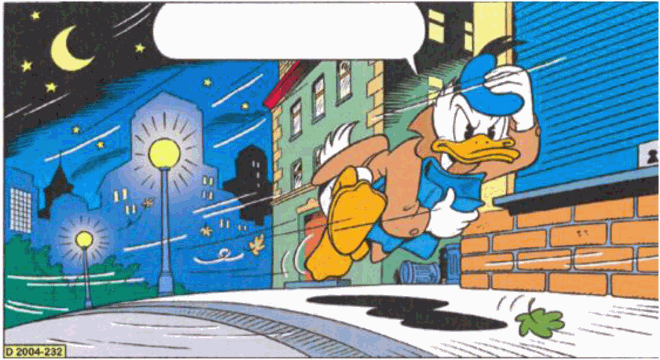
Panel 2. © Disney, used with permission.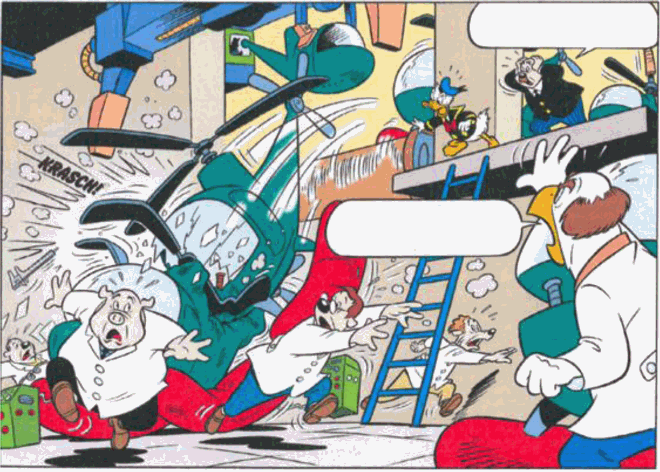
Panel 3. © Disney, used with permission.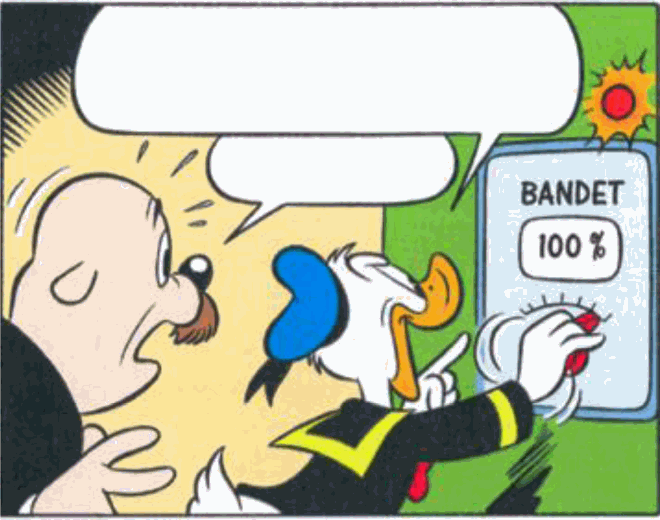
Panel 4. © Disney, used with permission.
Panel 5. © Disney, used with permission.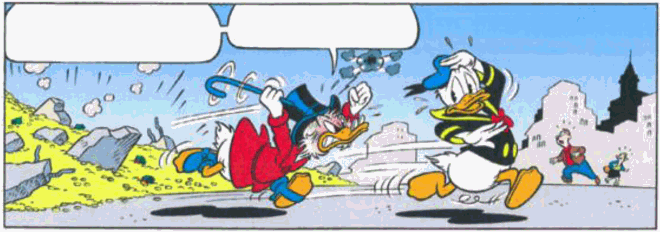
Panel 6. © Disney, used with permission.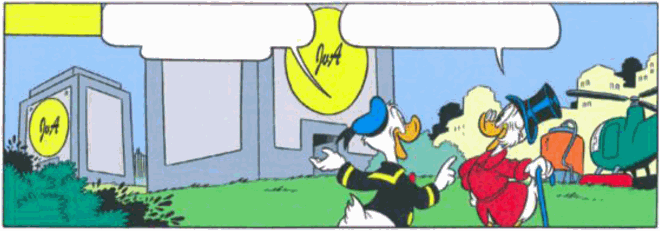
Panel 7. © Disney, used with permission.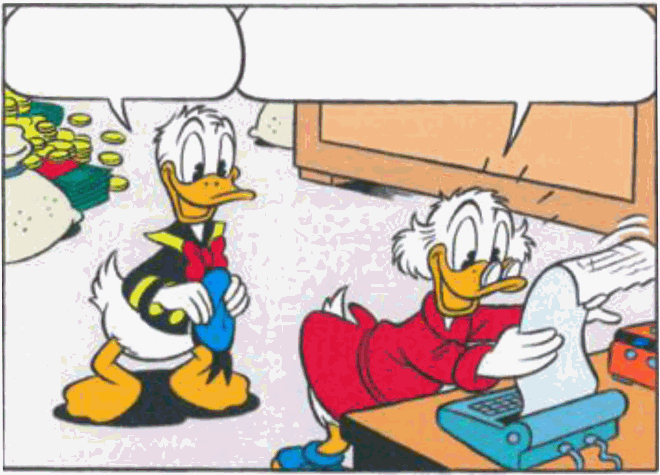
Panel 8. © Disney, used with permission.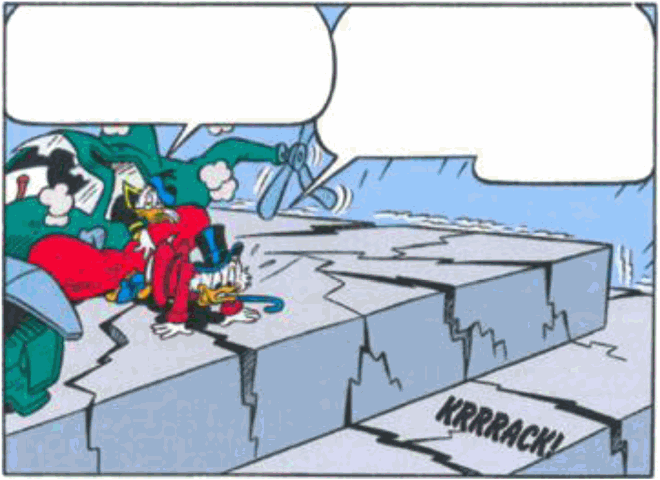
Panel 9. © Disney, used with permission.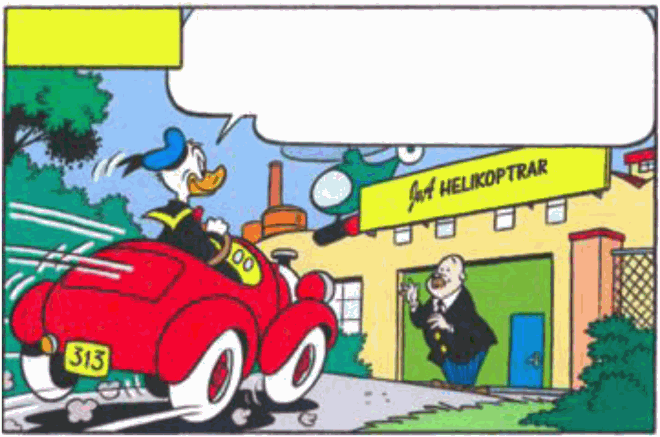
Panel 10. © Disney, used with permission.